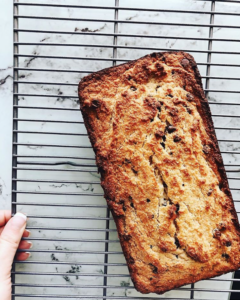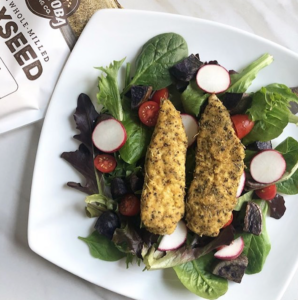Healthy Substitutes for Gluten-Free Baking and Cooking
Guest Post by Kasey Hutchinson, RDN

Smooth Whole-Milled Flaxseed is a great addition to a gluten-free diet as it can mimic the desirable qualities of gluten in both baking and cooking. Not only can it act as a binding agent but flaxseed also adds moisture and softness to baked goods. Flaxseed can even replace xanthan and guar gums, ingredients that are commonly used in gluten free baking.
Flaxseed is a nutrient power house offering a good source of fiber, protein, omega-3 fatty acids, vitamins, minerals, and phytonutrients to any diet. It works well in gluten-free cooking and baking as a substitute for many ingredients as well as offering a nutritious boost to any recipe.
Whole-milled flaxseed can be used as a substitute for gums, flours, breadcrumbs, and wheat germ. Learn how to do so below.
*Note: The substitutions listed below will not work with whole seeds. The seeds must be ground to have the same effect.
Table of Contents
ToggleHow to Substitute Flaxseed for Gums when Baking
Xanthan and guar gum are commonly used in gluten free baking, but they can be both expensive and hard to find. Some people also find that these gums upset their stomachs.
Replace xanthan or guar gum with a 1:1 ratio of ground flax plus twice the amount of hot water to make a slurry.
For example, if a recipe calls for 1 tablespoon of xanthan gum – mix 1 tablespoon of ground flax and 2 tablespoons of hot water, whisk to form a slurry.
How to Substitute Flaxseed for Flour in Baked Goods
While ground flaxseed cannot completely replace the flour in a recipe, it can easily replace about 1/4 of the flour called for. The rest of the all purpose or whole wheat flour should be substituted for gluten free flour.
If the recipe calls for 1 cup of all purpose flour, use ¾ cup gluten free flour and ¼ cup of Smooth Whole-Milled Flaxseed.
Try this recipe for gluten free banana bread!
*Don’t forget to add a little extra water when using ground flax since the additional fiber will soak up moisture!

How to Substitute Flaxseed for Breadcrumbs
For recipes such as meatloaf or meatballs, which require a small amount of breadcrumbs, use a 1:1 ratio when substituting ground flax.
If you are using breadcrumbs to make breaded chicken, fish, tofu, or veggies there are a few ways you can use flaxseed to replace breadcrumbs. You can either use just flaxseed as a 1:1 replacement or you can mix some flax with some gluten free flour. For example, replace 1 cup of breadcrumbs with ¾ cup gluten free flour and ¼ cup ground flax. Try this breaded chicken recipe to learn how.
How to Substitute Flaxseed for Wheat Germ, Wheat Bran, or Oat Bran
You can easily replace wheat germ, wheat bran, and oat bran with an equal amount of milled flaxseed as a healthy, gluten-free alternative.
The health benefits of milled flaxseed in gluten free recipes are so numerous and clear, it’s no wonder this food has gained such popularity in recent years. They offer a nutrient dense alternative to gums; anti-inflammatory properties; and a good source of fiber to benefit gastrointestinal health and help lower cholesterol.
Ground flax also works well in smoothies, oatmeal, baked goods, main dishes, and more. See more of our favorite gluten-free recipes here!
Kasey Hutchinson is a registered dietitian living in the Rocky Mountains of Northwestern Montana. Her professional expertise includes sustainable food systems, sports nutrition for the outdoor athlete, and technical writing. Check out her instagram page @vibrantnutrition_RD and blog at vibrantnutritionRD.com.
References
Christine. “5 Alternatives to Xanthan Gum and Guar Gum in Gluten-Free Baking.” Gluten Free Bread, 23 Mar. 2018, gluten-free-bread.org/5-alternatives-to-xanthan-gum-and-guar-gum-in-gluten-free-baking.
Kajla, Priyanka, et al. “Flaxseed—a Potential Functional Food Source.” Journal of Food Science and Technology, vol. 52, no. 4, 2014, pp. 1857–1871., doi:10.1007/s13197-014-1293-y.
Manthey, Frank A., et al. “Processing and Cooking Effects on Lipid Content and Stability of α-Linolenic Acid in Spaghetti Containing Ground Flaxseed.” Journal of Agricultural and Food Chemistry, vol. 50, no. 6, 2002, pp. 1668–1671., doi:10.1021/jf011147s.
Touré, Alhassane, and Xu Xueming. “Flaxseed Lignans: Source, Biosynthesis, Metabolism, Antioxidant Activity, Bio-Active Components, and Health Benefits.” Comprehensive Reviews in Food Science and Food Safety, vol. 9, no. 3, 2010, pp. 261–269., doi:10.1111/j.1541-4337.2009.00105.x.
